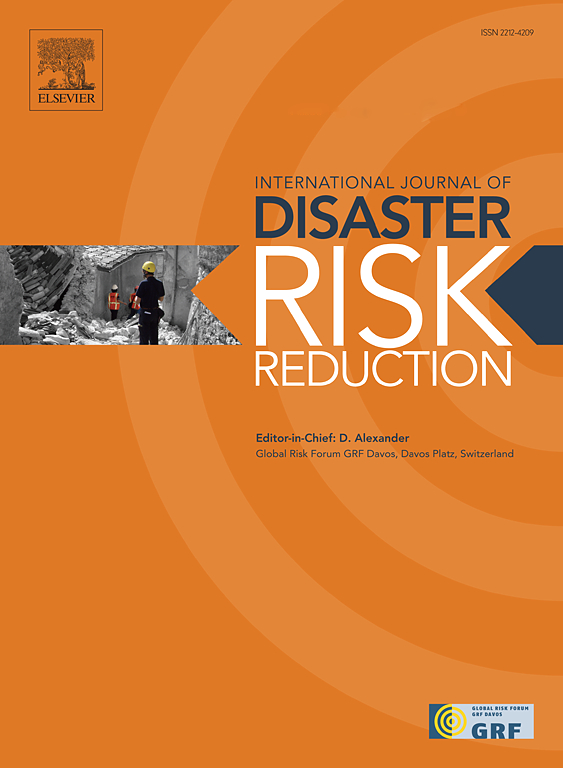山坡上钢筋混凝土建筑物的地震易损性和现有地震不规则性描述符的性能
IF 4.5
1区 地球科学
Q1 GEOSCIENCES, MULTIDISCIPLINARY
International journal of disaster risk reduction
Pub Date : 2025-05-29
DOI:10.1016/j.ijdrr.2025.105614
引用次数: 0
摘要
本研究调查了在丘陵地形中建造的四种常见类型的钢筋混凝土斜坡地面建筑的地震风险,即劈裂基础(SF),后退(SB),后退后退(SBSB)和平地(FL)建筑,按照印度规范的规定设计。这些选定的、设计的建筑物受到双向地震激励,利用22个地面运动记录进行非线性动力分析。采用概率地震需求模型、地震易损性函数、地震漂移危险曲线、年平均超出概率和倒塌裕度比(CMR)对SF、SB、SBSB和FL建筑的地震危险性进行了评价。结果表明:平房型和平房型的地震危险性相似,且小于平房型和平房型。从CMR中,研究发现,应用印度标准中的地震规定导致斜坡地面建筑物在50年内超过10%和2%的概率下具有令人满意的安全抗震性能。此外,倾斜的地面建筑通常有不规则的结构(平面和垂直),这决定了它们的抗震性能。文献中存在许多描述符,用于评估不规则建筑物(包括倾斜地面建筑物)的地震不规则性水平,这些描述符基于建筑物的几何形状或基本动力特性。最后,通过将地震危险性与不规则性描述符进行关联,评价了现有不规则性描述符在量化倾斜地面建筑物地震危险性方面的适用性和有效性。研究发现,现有的描述符与倾斜地面建筑物的地震危险性相关性较差。本文章由计算机程序翻译,如有差异,请以英文原文为准。
Seismic fragility of reinforced concrete buildings on hill slopes and performance of existing seismic irregularity descriptors
The present study investigates the seismic risk of four prevalent typologies of reinforced concrete sloping ground buildings constructed in hilly terrains, namely split-foundation (SF), stepback (SB), stepback setback (SBSB), and flatland (FL) buildings, designed as per provisions of Indian codes. These selected, designed buildings were subjected to bidirectional seismic excitation using 22 ground motion records for nonlinear dynamic analysis. The seismic risk of SF, SB, SBSB, and FL buildings is evaluated using probabilistic seismic demand models, seismic fragility functions, seismic drift hazard curves, mean annual exceedance probabilities, and collapse margin ratio (CMR). Results demonstrate that the seismic risk of SB and SBSB typologies is similar and less than that of the SF and FL buildings. From the CMR, the study found that the application of seismic provisions in the Indian standards resulted in satisfactory, safe seismic performance of the sloping ground buildings at the 10 % and 2 % probability of exceedance in 50 years. Further, sloping ground buildings typically have coupled structural irregularities (both plan and vertical), characterizing their seismic behaviour. Numerous descriptors exist in the literature for assessing the level of seismic irregularity in irregular buildings, including sloping ground buildings, based on their geometry or fundamental dynamic properties. In the final part, the paper evaluates the applicability and efficacy of existing irregularity descriptors in quantifying the seismic risk of sloping ground buildings by correlating the seismic risk to the irregularity descriptors. It is found that the existing descriptors are poorly correlated with the seismic risk of sloping ground buildings.
求助全文
通过发布文献求助,成功后即可免费获取论文全文。
去求助
来源期刊

International journal of disaster risk reduction
GEOSCIENCES, MULTIDISCIPLINARYMETEOROLOGY-METEOROLOGY & ATMOSPHERIC SCIENCES
CiteScore
8.70
自引率
18.00%
发文量
688
审稿时长
79 days
期刊介绍:
The International Journal of Disaster Risk Reduction (IJDRR) is the journal for researchers, policymakers and practitioners across diverse disciplines: earth sciences and their implications; environmental sciences; engineering; urban studies; geography; and the social sciences. IJDRR publishes fundamental and applied research, critical reviews, policy papers and case studies with a particular focus on multi-disciplinary research that aims to reduce the impact of natural, technological, social and intentional disasters. IJDRR stimulates exchange of ideas and knowledge transfer on disaster research, mitigation, adaptation, prevention and risk reduction at all geographical scales: local, national and international.
Key topics:-
-multifaceted disaster and cascading disasters
-the development of disaster risk reduction strategies and techniques
-discussion and development of effective warning and educational systems for risk management at all levels
-disasters associated with climate change
-vulnerability analysis and vulnerability trends
-emerging risks
-resilience against disasters.
The journal particularly encourages papers that approach risk from a multi-disciplinary perspective.
 求助内容:
求助内容: 应助结果提醒方式:
应助结果提醒方式:


